Suede vs Roughout Leather: Does One Make Tougher Boots?

Expert Verified By: Michael Batson, Vice President, North Star Leather Company
There are countless ways to make different leather products, and while the average person would have trouble differentiating some of them, even shoe brands themselves are likely to mix up suede and roughout, the two kings of the fuzzy footwear.
You’ll sometimes hear roughout referred to as a kind of suede while others will collapse laughing at such a mistake. Who’s right? Is one better, tougher, fancier, easier to clean?
To answer, we interviewed the world’s best-known suede producer over in England, and we spoke to a professional leatherworker here in the United States. Both products are fuzzy, and in both cases, the fuzz (you should call it “nap”) is fibers from the animal’s flesh.
But wait, there’s more…
Key Takeaways: Suede vs. Roughout
Roughout Leather: A regular piece of full-grain leather that’s simply been turned over, so the fleshy “inside” is now facing outward. Also called reverse suede and flesh out.
Suede Leather: Leather that’s been split down the middle so it doesn’t have the outer layer of the skin, or “grain” — now, both sides of the product are fuzzy with fleshy fibers.
They usually look similar and are quite scratch resistant, but roughout is more often used on harder wearing footwear, since it tends to be thicker and less water absorbent.
Is Roughout the Same Thing As Suede?
We spoke to Andrew Bailey, the sales director of Charles F. Stead, universally considered the finest suede producer on Earth. Putting aside how many different forms suede can take (that’s another article), Bailey is someone who considers both products “suede.” In fact, another term for roughout is “reverse suede.”
“Suede is effectively produced on the corium area of the skin beneath the outer layer,” he explains. “That can be done by taking a hide and just flipping it over to produce a classic reverse suede, or roughout as it’s sometimes called; or it can be done by taking a hide, removing a thin grain layer, and then utilizing the rest of the hide.”

In short, they’re both leather products that have a fleshy side facing outward instead of the usual smooth grain side. The difference is that suede has had the outer layer of skin split off of it by a machine, while roughout is made by simply turning the leather over: the skin layer (the “grain”) is still intact, you just aren’t seeing it.
Further Reading
Nubuck vs Suede: Why The Difference Matters
Two other forms of leather that are often confused, but are used for different purposes. Learn more →

What Is Roughout Leather?
“Full grain suede, reverse, flesh out, and roughout are all the same,” says Michael Batson, owner of North Star Leather. “Roughout (and all the other terms) includes the grain side of the leather, so it’s basically a top grain or full grain leather that’s been flipped to use the ‘fuzzy side’.”
Roughout leather is the underside of a hide’s grain, the underside of the skin. The leather turned inside out.
Boot leather is usually around two millimeters thick, but the hides that arrive at a tannery are much thicker, so they get split. Suede is split so as to have the grain part removed (producing two fuzzy fleshy sides), while roughout only discards a layer from the flesh side.

“If you were to look at the whole hide, you’d have a smooth side and a fuzzy side,” says Batson. “Think of a loaf of bread: typically, the smooth crust faces out, just as most leathers show the outer side of the hide. With roughout leather, the fuzzy inner surface is exposed, typically sanded to enhance the texture, while still retaining the full grain of the leather. It’s textured and tough, generally used on workboots built to take a beating.”

What Is Suede?
Both sides of a piece of suede are soft and nappy because it’s leather without the outer layer of the skin to be found: the hide got split in a way that took the skin part right off. The fuzz is flesh. Both sides are fleshy now!
So roughout is from the underside of the skin, whereas suede is made by splitting the skin down the middle.
The name comes from the French “gants de Suède” or “gloves from Sweden” because this material was originally used exclusively for garments with maximum softness and flexibility — the kind of thing you wear next to your skin. Indeed, suede can be really thin, supple, and soft.
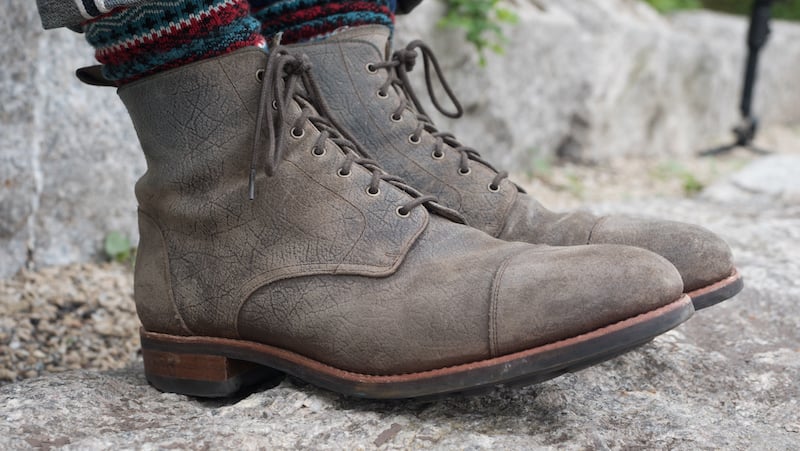
But you can also make suede that’s thick enough for work boots. A hide is very thick, and all you need to do for an article to be considered “suede” is to remove the grain layer — you could make suede that’s too thick to be used for boots at all.
“A shoemaker is going to use leather anywhere from one millimeter to two millimeters thick — perhaps up to three for a heavy boot,” says Bailey. “But that same thickness can be provided on a suede or a grain. And you can get some very thin full grain leathers.”
It’s easy to get caught up in exceptions and semantics here, but it is important to remember what we’ve said about what suede and roughout are and what suede and roughout tend to be. Suede tends to be thinner and more delicate, but it doesn’t have to be — but odds are that if you’re looking at a suede boot and a roughout boot, the roughout one is better for hard wear.

How They Handle Water: Suede, Roughout, and Waxed Suede
Maybe the most important difference is that roughout usually handles water better than suede: droplets will typically evaporate from roughout just fine, while they usually leave spots on suede that need to get brushed out.
“Maybe it’s that suede can absorb deeper, as it’s more porous,” says Batson. “With no grain layer on either side of suede, it tends to be more breathable. But the difference in waterproofness could also just be a correlation: roughout will tend to be made for more rugged boots than true split suede.”
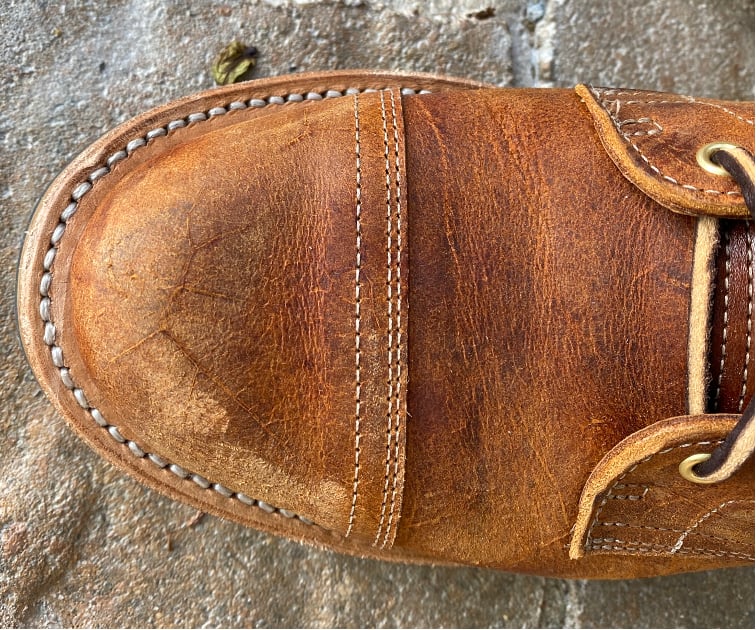
This is why, when it’s used on harder-wearing boots, suede usually gets a layer of wax applied to it before you buy it. Suede is already very scratch resistant on its relative to full-grain leather, and adding wax adds water and stain resistance to its properties.
“You will not get anything more durable than waxed suede,” says Bailey. “Not only is it completely resistant to water and staining, but you don’t have to worry about scuffing it. With a grain leather, you can scratch it and damage the epidermis, and there’s no way of repairing that.”
There are other ways to make suede more waterproof, though. In the video above, we visited a facility in Mexico that makes the “Weatherproof” suede used on some of Thursday’s boots. By imbuing it with oils and waxes earlier in the production, this kind of suede is waterproof while looking a lot more like regular suede than waxed suede.
Further Reading
How to Wax Suede Boots
Already own suede boots and want them to be better at handling wet weather? Here’s how to wax them yourself! Learn more →

Look and Feel
Suede and roughout can vary greatly in look and feel, just like any other kind of leather. Beyond their fuzzier texture, there are no hard and fast rules. It all depends on how the material is treated, both during and after the tanning process.
Sometimes the fibers are shorn down very short, but you’ll sometimes find extra rough suedes that have extra hairy surfaces — check out these from Grant Stone:
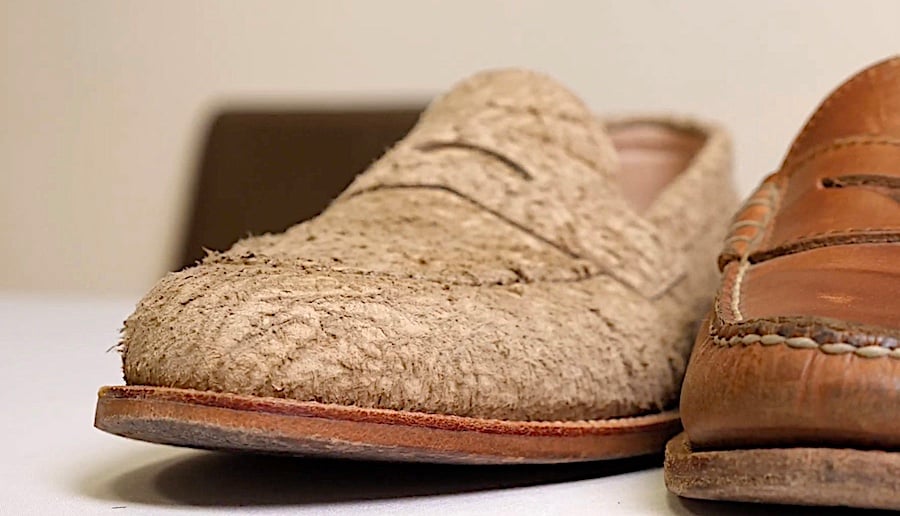
Neither are smooth, but roughout is usually a little smoother than suede. Neither have to be any particular thickness, but suede tends to be thinner and therefore more comfortable and breathable. Both are scratch resistant and both tend to get waxed when they’re used on harder wearing footwear.
“If you check out CF Stead, you can see some really crazy wax and other effects that they apply,” says Batson. “In Red Wing‘s lineup, Hawthorne Muleskinner is a roughout that’s had some oil and wax applied, whereas Spitfire has so much that it appears smooth, while Mohave feels like a normal suede.”
Bottom line: if the grain is raised, it’s probably roughout or suede. Other than that, there are no hard and fast rules about how these materials can look.

Suede vs Roughout Cost
A lot goes into figuring out the cost of leather, and so it’s hard to generalize if roughout or suede is more expensive.
On the one hand, roughout uses a full-grain leather, which is typically more expensive than a split. On the other hand, suede has a longtime association with luxury that means there’s some really, really nice suede, with hefty price tags to match.
Batson agrees. “Generally, suede is cheaper if you’re comparing tanneries of the same quality tier, but you can still pay a lot for a good suede,” he says. “In fact, a suede from a top tannery like CF. Stead would easily cost double the cost of full grain from a tannery like Leader in Pakistan.”
The short answer: it’s too complicated to say one’s more expensive than the other. There’s way more that goes into making a leather product than where it’s been split.
Suede vs Roughout Care and Cleaning
Generally, you’re fine getting roughout wet, which is part of why it was such a popular option for soldiers’ boots during the World Wars. (See our review of Oak Street’s World War 2-inspired Field boots for a closer look at roughout service boots.)
But suede usually looks worse for wear after getting caught in the rain. Don’t put your wet shoes in front of the radiator, though. That isn’t good. Instead, towel them down with a soft cloth and, if you have them, wrap a cedar shoe tree in some plain printer paper and stuff ’em in the shoes. This will absorb water from the inside.
Brush them down with a wire bristle brush the next day. They’ll probably be fine, unless they got a lot of dirt on them too, in which case — check out our guide to cleaning suede with suede shampoo.

Conditioning is generally not necessary or recommended for suede or roughout. Applying those creams and waxes is likely to change the texture permanently.
If you’re very concerned about water damage to your boots, you can always try a silicone-based waterproofing spray, like this one from Saphir, which can add a bit of protection without affecting the appearance of the shoe much.
If this all sounds like a headache, take a look at Thursday Boot Company’s Weathersafe Suede, which is imbued with hydrophobic materials during the tanning process to make for a great-looking suede that’s very water resistant.
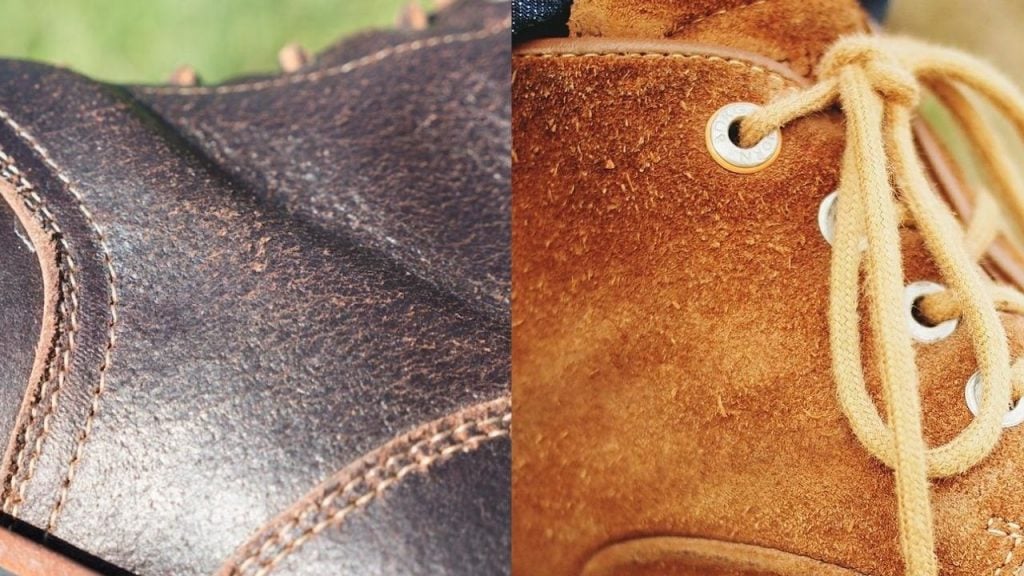
There you have it! The definitive guide to two iconic boot materials. Whether you’re looking for something suave and dressy or tough and fuzzy, there’s a textured leather out there for you.

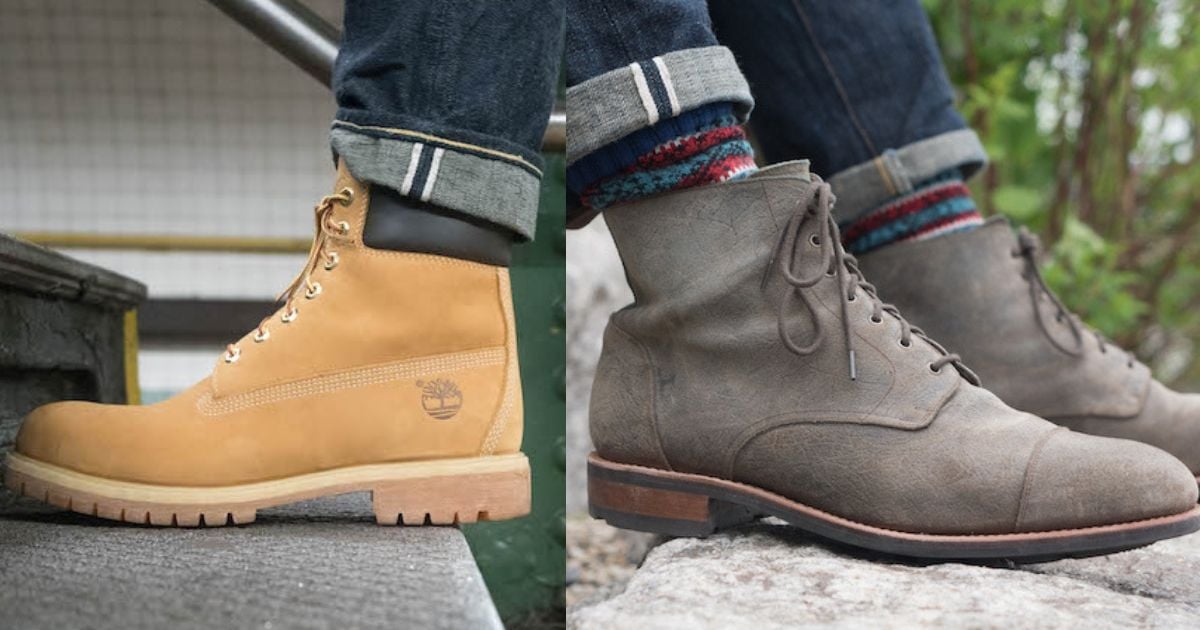

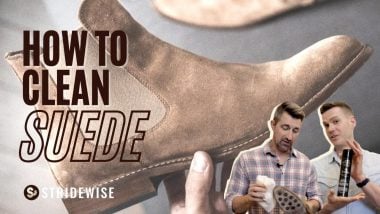





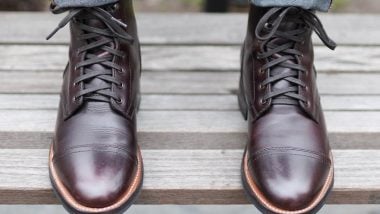

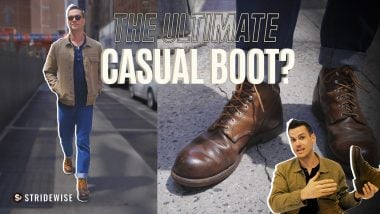
Any tips on ‘re-waxing’ a boot made from Horween’s waxed flesh (like the Thursday Logger?) I’m just curious once the wax starts to wear off if it’s better to rewax or apply a water protectant to keep it safe from the elements.
I think rewax it, and I’m pretty sure you just heat a tin of wax (like Filson’s or something) and spread it on, but you might want to check out some Carl Murawski videos for a visual aid there. I’ll get around to doing an article/video on it myself one day though!